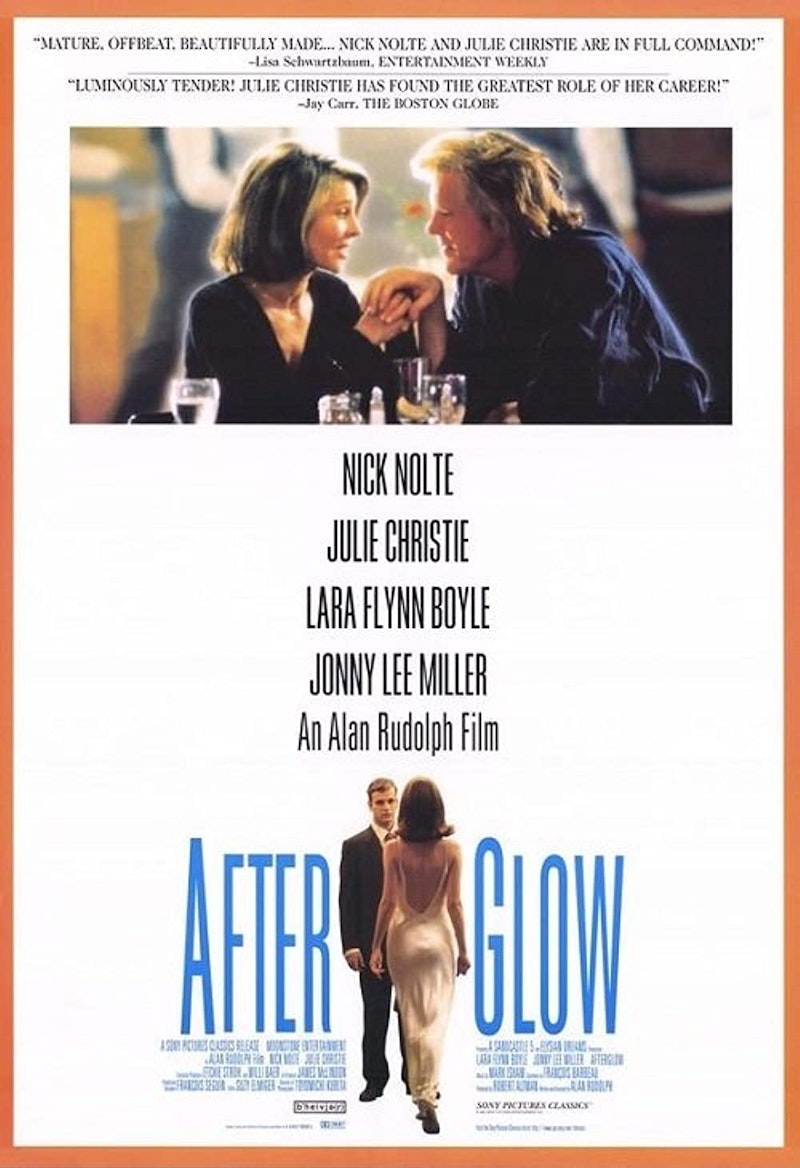It was 1997 and we late-Gen-Xers though we knew what the 1990s were about and what the future might hold.
We were wrong.
I recently re-watched Alan Rudolph’s Afterglow, a mixed bag. On one hand, Julie Christie’s Oscar-nominated performance is a knockout; on another, it often flails like a local drama club improv session—Johnny Lee Miller wields his Canadian accent like a cudgel, and some of the subplots flounder like goldfish on a kitchen counter.
Whatever you make of it, Afterglow has 1997 in spades, in all its cigar-smoking glory.
What’s 1997? Everyone’s doing well financially. Everything’s wood-grained and golden-hued, like a Borders Books and Music of the era. Everyone is going out to eat, hanging out in hotel bars or coffee shops. Since there’s nothing left to worry about (history just ended, ask Francis Fukuyama), our sad pasts are coming back to haunt us as we sit around watching old movies playing on cathode ray televisions. There really isn’t much else to do but be tragically beautiful, try to conceive, play with your new electronic system’s remote, and wear impeccably-tailored outfits that are somehow both Breakfast at Tiffany’s and Twin Peaks (over to you, Laura Flynn Boyle—how is her look in this series not a Pinterest board?).
If Afterglow is the end of something, Stephen Norrington’s Blade, from 1998, is the beginning of something else.
What’s 1998? Everyone’s doing terribly. You can just fire off shots in the street and people panic for a moment and then go back to their sad, shuffling lives like they really are non-player characters. Everything is metallic gray. Everyone’s going out to vampire raves, bathing in blood, and luring in new victims. The vampire youth endlessly listen to techno, zoning out while their computers figure things out for them. There really isn’t much to do but be pale and listless, get lost in the rave trance, wear lots of leather, and attempt to summon the apocalypse.
I understand that history and film are messier than this. Afterglow was filmed in Quebec while Blade was developed for a Los Angeles shoot. Both films passed by me at the time, noted and watched, but just more forest for the trees.
But the world of Afterglow has no real forward momentum, thematically or influence. It does fit into a certain Canadian film lineage of the time: it’s not for nothing that a book on that subject is called Weird Sex & Snowshoes, and I’m sure a line can be traced considering the complications and coincidences between two couples that lead the film straight to the Romance section of the video store. You also get a whiff of Altman, a mentor of Rudolph’s who produced many of his films; the intertwined tales of Afterglow could be Short Cuts interpolations.
But Blade is about to reign supreme. Loud techno, black leather trench coats, a certain flavor of cocky youthful nihilism? This is the making of a new template. This is the year 2000 on the horizon, pre-millennial tension. I remember people completely blown away by 1999’s The Matrix during its first theatrical run, imploring me to see it, saying, “This is way forward. This is something new.”
It wasn’t entirely new: just like Sam Rami seeing Japanese horror films before most of us and making films that felt radical to Western viewers, the forces that led to the era of the “Trenchcoat Mafia” were bubbling up. KMFDM released their first tracks in 1984, after all. Their infamy was to come later.
I’m very aware that I can’t go back to 1997. But, for one hour and 53 minutes, I can be transported back to a time before 1998. Not a drum and bass track in sight. No red or blue pill to take. Not a single black leather trench coat. No CGI winged vampire skeleton demons.
And, for that, I remain grateful.

